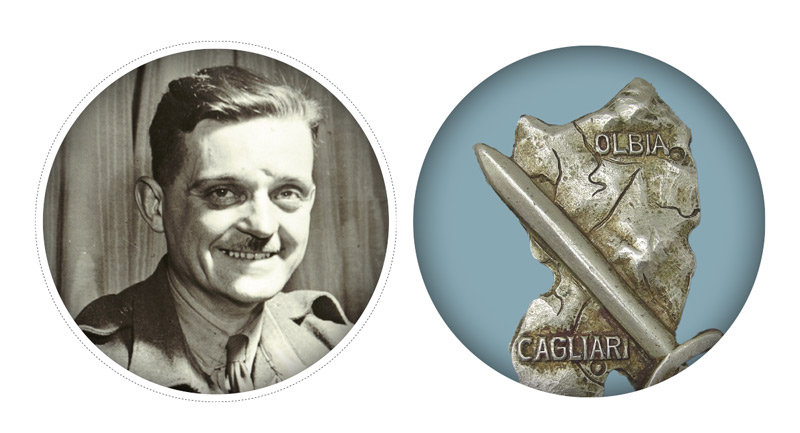
The Sardinia Shield was worn by original members of the 90th Panzer Grenadier Division after it was formed on the Italian island in 1943.[originalgermanmilitaria.com]
On Dec. 10, 1943, the 1st Canadian Infantry Division’s advance on the Italian town of Ortona was blocked. For four days, a number of battalions were chewed up in unsuccessful attacks in the area the Canadians called The Gully. The 90th Panzer Grenadier Division was fully exploiting the geographic advantages provided by the deep ravine, the presence of which had been entirely missed by intelligence staff. On Dec. 14, however, the Canadians discovered the nearly five-kilometre-long gully could be outflanked where a three-storey, white stucco manor called Casa Berardi stood. Win the house and an advance along the Ortona-Orsogna road that paralleled the feature was possible.
The Gully was turned, an epic fight won.
At 7:15 a.m., Captain Paul Triquet of the Royal 22e Régiment led ‘C’ Company’s drive to the villa. The 33-year-old came from a long line of French military veterans. Lying about his age, Triquet had enlisted in the Van Doos at 17. A sergeant major in 1939, he received an officer’s commission shortly after the regiment deployed to Britain.
‘D’ Company advanced alongside ‘C,’ but incoming fire and the confusing terrain of vineyards and olive groves caused it to drift out of the fight. Triquet managed to keep on track with seven Ontario Regiment tanks following. Triquet called the ensuing assault “one long cavalry.” His men pushed on despite significant casualties.
Just 200 metres short of the house, a severe barrage reduced the force to less than two dozen Van Doos and five tanks. “There are enemy in front of us, behind us, and on our flanks,” Triquet yelled. “There is only one safe place—that is on the objective.”
By mid-afternoon, they gained the manor. By midnight, only 14 of the 22nd were still fighting when ‘D’ Company reinforcements arrived. German counterattacks the following day failed to dislodge the Canadians. The Gully was turned, an epic fight won.
Awarded the Victoria Cross, the government brought Triquet home to promote French Canadian involvement in the war. In Montreal, 300,000 people watched him paraded by in a car. He then toured the country for the 6th Victory Loan campaign.
Deeply uncomfortable with the public relations role, Triquet desired to return to the Van Doos. After the war, he was promoted to lieutenant-colonel, but he struggled with alcoholism, owing to what he called “the noise of the mind.” Forced to retire in 1947, Triquet overcame his demons in the 1950s, then joined the reserves and retired as a brigadier in 1960. He died in 1980.
During the Canadian advance to Ortona across the Moro River and the Gully that started on Dec. 6, 1943, the opponent was the 90th Panzer Grenadier Division. Originally designated 90th Light Infantry Division, it had been one of the Afrika Korps’ finest units. All but destroyed in May 1943, it was rebuilt two months later as one of the new panzer grenadier divisions Hitler had ordered created after Stalingrad. Such divisions were highly mechanized in order to operate independently or alongside Panzer divisions.
Many of its soldiers had been serving since the September 1939 invasion of Poland. The 90th consisted of two infantry regiments of three battalions supported by a tank battalion, artillery regiment, anti-tank battalion and engineer battalion. Each infantry battalion was heavily equipped with 59 light and 12 heavy machine guns, three 7.5-centimetre anti-tank guns, six 8-centimetre mortars and four 12-centimetre mortars. The machine guns gave it tremendous firepower. Although its mandated strength was 14,000, in December 1943 it was well below that number.
From the Moro to The Gully, the 90th contested every bit of ground, meeting each advance with fierce counterattacks that cost both sides dearly. On Dec. 9, Generalleutnant Karl-Hans Lungershausen drew the division back to The Gully—the last bastion barring the way to Ortona. The following day, he was notified that reinforcements from the 1st Fallschirmjäger Division were coming. Until they arrived, however,
the 90th fought on.
The Gully perfectly suited the Panzer Grenadier Division. Showing on Canadian maps as nothing more than a thin line, it was almost five kilometres long from the sea to where it levelled out at Casa Berardi. It went from 300 metres wide at seaside to 80 metres at its westernmost extent. The average depth was 60 metres. Its slopes were steep.
They were able to defeat every frontal attack until Triquet’s Van Doos turned their flank.
The panzer grenadiers dug fighting pits at the top of the southern bank, as well as additional pits further downslope, which they sheltered in during the Canadian artillery barrage that preceded every battalion assault. When the guns ceased firing, the grenadiers rushed up the slope to engage their machine guns in the fighting pits. Doing so, they were able to defeat every frontal attack until Triquet’s Van Doos turned their flank.
Then the 90th pulled out. On Dec. 14, the war diarist of the 76th Panzer Korps—of which 90th Division was part—wrote: “Enemy…in the exploitation of today’s success, presumably will take Ortona.”
Advertisement






















